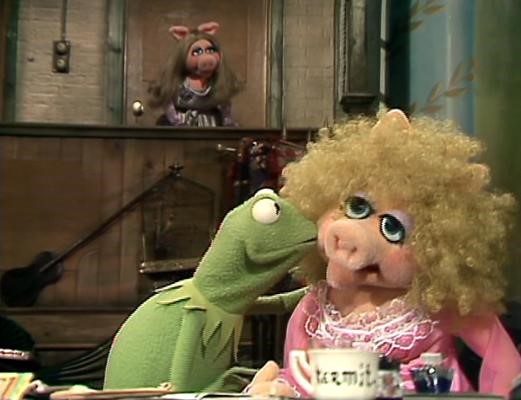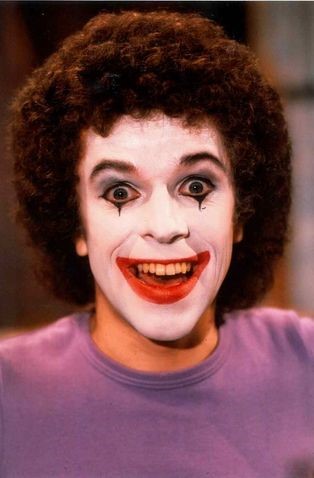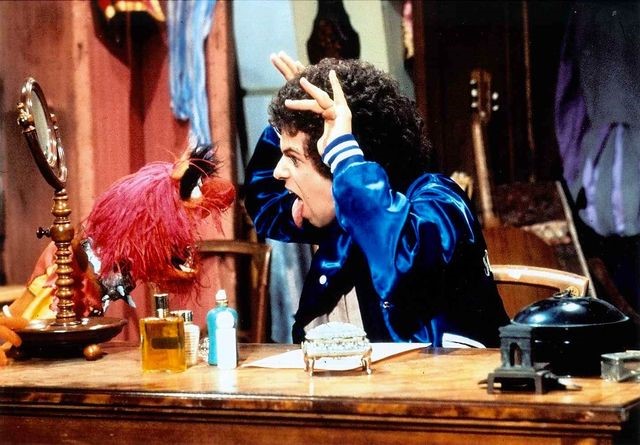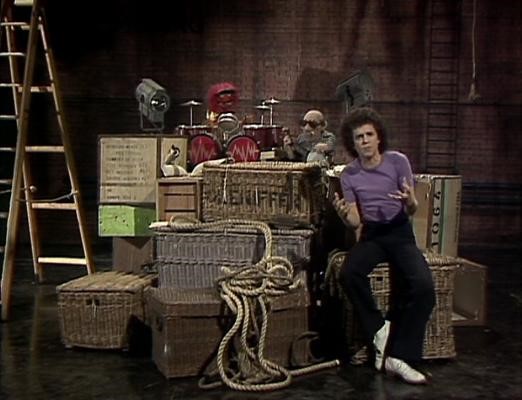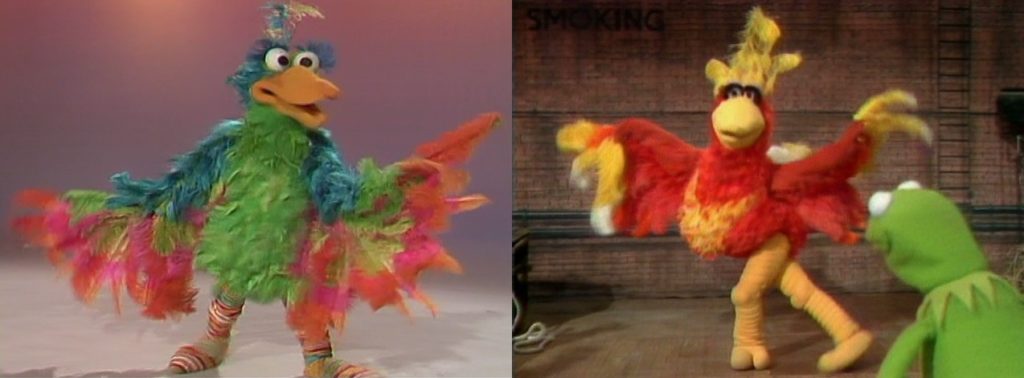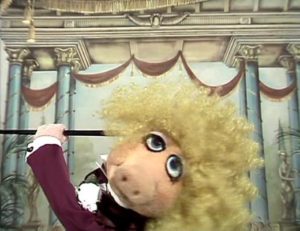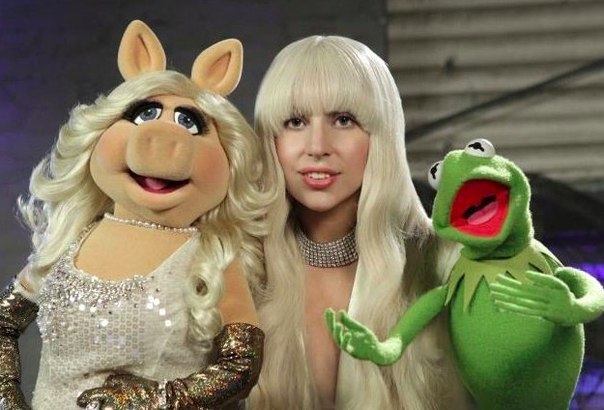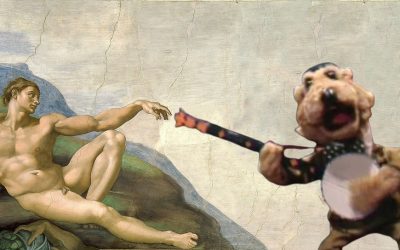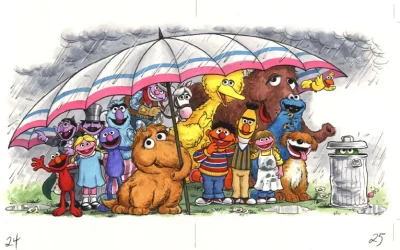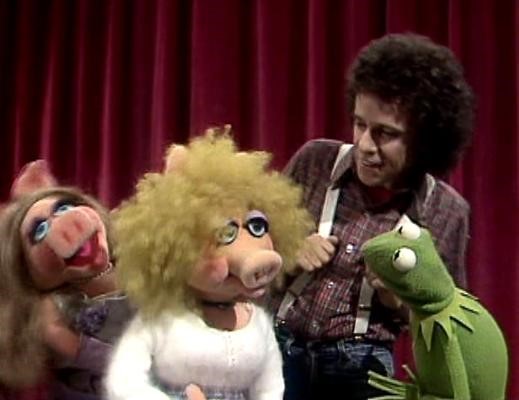 Original air date: December 7, 1978
Original air date: December 7, 1978
The Leo Sayer episode of The Muppet Show is many things. It’s layered. It’s got depth. It introduces the audience to some characters, and has some characters introduce themselves… to themselves. It’s about feminism and identity and expectations that we get from others, and some that we give ourselves. And it’s also got two pigs fighting over a frog and a giant dancing bird. Buckle up, ’cause we WILL let the show go on! Come along as I try to unpack this episode.
Okay, so the A-plot backstage story centers around the formal introduction of Annie Sue Pig. While seen in the background of season 2 and elsewhere in season 3, this is Annie Sue’s true origin story. Kermit introduces her to Miss Piggy (and essentially to us, the audience) as the “new girl singer,” and Miss Piggy is pretty chill about the whole thing. “I am a woman singer,” she proudly proclaims. Piggy displays a high level of confidence and poise as she never lets it bother her that another female will be singing on the show.
That is, until she finds out that Annie Sue is a pig. Thus begins a petty display of insecurity as Miss Piggy subliminally fears she’s being replaced. It’s an ugly side that we all can have – a fear of being cast aside for the newer, younger model. And this episode came at a time when Miss Piggy was approaching the height of her popularity, so the audience probably had the same concerns when Annie Sue first appeared in this scene. But as we all know, Miss Piggy’s personality is too big and too bold to ever be replaced.
Annie Sue talks about having watched Miss Piggy since she “was a baby,” which is such a smart commentary on the aging out of women in Hollywood. Miss Piggy is a character who is most likely in her mid-thirties, but was essentially just 3 years old when this episode first aired. That Jim Henson and his writing staff would address a woman’s age and that triggering questions of replacement in this way is truly delightful. Not to mention the dichotomy of the two women – Miss Piggy being the show biz pro who can sense even a hint of being pushed out, on-stage and off (Cheek-kissing between boss Kermit and new, young employee Annie Sue? Kermit better watch that privilege he’s using there), and the eager-to-learn Annie Sue who wants to bask in the greatness of her idol, no matter how much she slyly demeans her. It says so much about rivalry in the workplace and sisterhood, at a time when the second-wave women’s rights movement was in full-swing. I don’t think I’m reading too much into the episode when I say that this is one of the most feminist Muppet Show episodes ever, and it still has some lesson to teach today.
Tied into that, in a totally different way, is the idea of identity and where we belong in the world. And Leo Sayer is on display in that regard, bouncing between identities and figuring out where he belongs in the world. Take for example the performance of “The Show Must Go On.” He sees himself at times as a mime, a clown performing for others while not being able to say how he truly feels. He has a dual persona that even he doesn’t understand, that comes and goes as it pleases, and gives him a mask to hide from the world. Even when he’s in his element – singing his love song “When I Need You” – he runs away. Is it for fear of his own life? Sure, I guess so. But is it also running away from himself and his feelings? Maybe!
During his opening number for “You Make Me Feel Like Dancing,” Sayer sings of feeling out of his own control, being so moved for the other person that he is compelled to dance, as though he is entranced. Are his actions a result of his own want, or the desires of someone else? Something to consider while doing your own soul-searching. Not to mention Sayer being extremely Muppety in his movement and every time he dances. Is he a man, or is he a Muppet? You decide!
At the end of the day, this episode leaves us with some questions: Who is Miss Piggy? Who is Annie Sue? Who is Leo Sayer? Who are you? Are you a human, or are you a Muppet? The ambiguity of these questions probably provide uncertainty in your answers. So maybe we should be asking a more important question: When did Bobby Benson learn to play the banjo?
Best Joke: Not a joke per se, but Leo Sayer’s facial expressions in his numbers had me cracking up hard.
Lamest Joke: “Lame” here could stand in for “inappropriate today” but I’m gonna go with Statler & Waldorf saying that Annie Sue will make The Muppet Show worth attending, so they ponder if they should “shoot her now.” I mean, I get it – but they could’ve gone with talking her out of it instead of performing violence against a woman.
MVM (Most Valuable Muppet): Annie Sue is given her first (and pretty much last) chance to shine.
Most Classic Moment: I don’t know how many people fondly remember “You Make Me Feel Like Dancing” the way that I do, so it’s either the “Most Classic Moment” or the “Should-Be-Classic Moment,” but it’s definitely the “Musical Highlight.” That face! Those moves! That bird! It’s just so dang good.
First Appearance Of… Fletcher Bird – A full-body, multi-colored dancing bird performed by (and named after) dancer Graham Fletcher, and who I always picture in my head when I talk about Betsy Bird. They are apparently not the same.
One More Thing… As Louise Gold was still learning the puppetry ropes at this time, Frank Oz performed Annie Sue during the “Carbon Paper” number, to Louise Gold’s vocals. Gold felt that she didn’t have enough experience to puppeteer that number. And not to brag, but I totally guessed this then looked it up later on Muppet Wiki to confirm. It’s all about the face she makes at the end of the number.
Click here to pass the Bechdel test on the ToughPigs forum!
by Matt Wilkie

